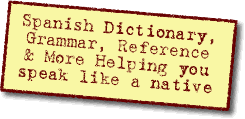Ask a Question(Create a thread) |
|
|||||||
¿Comienza con ‘que’ las conjugaciones en el subjuntivo?Grammar questions– conjugations, verb tenses, adverbs, adjectives, word order, syntax, etc. |
 |
|
|
Thread Tools |
|
#1
|
|||
|
|||
|
¿Comienza con ‘que’ las conjugaciones en el subjuntivo?
El subjuntivo se conjuga así comenzando con la palabra "que":
Que yo vaya Que tu vayas Que él vaya Que ella vaya Que nosotros vayamos Que vosotros vayáis (sólo en España) Que ellos vayan |
|
Get rid of these ads by registering for a free Tomísimo account.
|
 |
«
Previous Thread
|
Next Thread
»
| Link to this thread | |
|
|
|||||||
 Similar Threads
Similar Threads
|
||||
| Thread | Thread Starter | Forum | Replies | Last Post |
| Quedarse con las ganas | Iris | Vocabulary | 17 | June 01, 2010 08:48 PM |
| Imperfecto del Subjuntivo | Hombre-Araña | Grammar | 23 | August 17, 2008 06:29 AM |
| Las cosas nuevas | MonteChristo | Practice & Homework | 15 | May 26, 2008 02:33 PM |
| el subjuntivo | gramatica | Grammar | 4 | July 27, 2007 11:15 PM |
| ¡Feliz Día de las Mamás! | Tomisimo | General Chat | 1 | May 11, 2007 12:50 PM |
All times are GMT -6. The time now is 11:00 PM.







